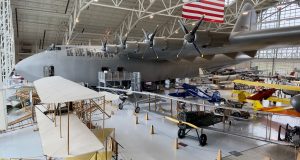The 30-Second Ride of the Spruce Goose
by admin | March 30, 2023 7:41 pm
McMINNVILLE, OREGON – On a rainy late-winter morning, my buddy Glenn and I headed southwest from Portland to McMinnville, about 35 miles away. The town is roughly the size of Lufkin and is home to the Evergreen Aviation and Space Museum, three large buildings (one is a movie theater), across from the airport and surrounded by a vineyard. The museum was founded by Evergreen International Aviation, known mainly for commercial helicopter operations. The company went belly-up in 2013, but not before founding the museum about two decades earlier, in 1991. The following year, Evergreen won the bid to buy the Spruce Goose, the largest seaplane, wooden aircraft and propellor plane ever built. We drove to McMinville to pay the Spruce Goose a visit, plus enjoy looking at other aircraft and spaceships.
The Spruce Goose was the brainchild of Henry Kaiser, a famed steel magnate and shipbuilder. In 1942, Kaiser enlisted Howard Hughes, an aviation pioneer, Hollywood director and germophobic, to build a massive flying boat that could ferry troops and materials across the Atlantic Ocean to aid the Allies in the war against Germany. Kaiser pulled out of the deal, but Hughes continued, directing the construction of this massive aircraft.
Steel was scarce because of the war effort, so Hughes elected to build the plane out of laminated wood — mainly birch but with enough spruce to warrant the nickname. The Birch Lurch likely would not have worked as a moniker. The plane’s wingspan topped 320 feet, a bit more than a football field’s length, and it stood nearly 80 feet high. The Spruce Goose weighed 300,000 pounds empty, had eight 28-cyliner Pratt & Whitney engines and a cruising speed of 135 mph.
At least that is the official cruising speed, according to the museum’s website. Five years after the project began, on Nov. 2, 1947, Hughes and his crew shocked onlookers in Long Beach Harbor, California by turning what was supposed to be a taxiing test into an actual flight – albeit a short one that likely never reached 135 mph. Getting about 25 feet above the water, the Spruce Goose stayed aloft for about 30 seconds. It was its one and only flight. World War II was over  [1]and thus the need for an aircraft of this size. The federal government shelled out $23 million in development costs for the plane and once hauled Hughes before Congress to grill him about the expense.
[1]and thus the need for an aircraft of this size. The federal government shelled out $23 million in development costs for the plane and once hauled Hughes before Congress to grill him about the expense.
Hughes eventually reached a deal to keep possession of the Spruce Goose and employed a crew of 300 to keep it in flying condition, in a hangar off the harbor. After the increasingly eccentric billionaire died in 1976, an aviation club acquired it and put it on display. Eventually, the Walt Disney Company owned it until selling it to Evergreen.
After the sale, the Spruce Goose was disassembled and hauled by train, truck and barge to McMinville, where workers spent the next eight years reassembling it, removing all the paint, and repainting it. The last piece of the Spruce Goose was put in place in late 2001.
Words, even photos, do not do justice to the immensity of this plane. Several biplanes are displayed beneath its fuselage, looking like toy planes from a distance. From an upstairs balcony, I tried to capture a photo of the entire Spruce Goose. Even with a wide-angle lens, it was not possible to fit the entire wingspan into the photo.
After touring the Spruce Goose (most of the interior is off limits unless you wanted to shell out $30 for a guided tour; we declined), we wandered around the rest of the museum before heading across the courtyard to the space building. Not to be outdone by the Spruce Goose, this museum features a Titan II rocket, which powered the Gemini missions into space, the SR-71 Blackbird, the fastest jet ever made with a stop speed three times the speed of sound at 2,000 mph, and a life-size replica of the Apollo lunar lander. Cool stuff for a lifelong space nerd like me.
A few dozen retired aviation folks in green vests voluntarily milled about to answer questions, all clearly enjoying their unpaid jobs. On a dreary, wet Oregon winter’s morning, this was not a bad place to hang out. I know we enjoyed our time there.
- [Image]: http://garyborders.com/pages/the-30-second-ride-of-the-spruce-goose/spruce-goose-for-col/
Source URL: https://garyborders.com/pages/the-30-second-ride-of-the-spruce-goose/